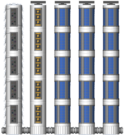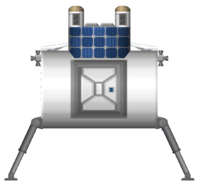Colonial Posessions of Shazbotdom throughout the Solar System
Jump to navigation
Jump to search
The Shazbotdom Empire is planning on instituting at least one Colonial Posession on Mars, Venus, and Luna. With the possibility of more to be added over time. These will be built by the Shazbotdom Imperial Space Administration.
Segments Used on Terrestrial Colonies
Standard Segments
- These Segments are standard for Colonies that are slated to host human life. These will be the primary segments utilized for the Lunar and Martian colonies.
Hydroponics Farm Segments
- In an effort to maintain the Lunar Colonies as self-sustaining, the Imperial Space Administration is in the process of developing multi-use Farming Segments for several smaller Farming Colonies that will be strategically placed on the Lunar Surface to grow food for the Colonies. These Farming Colonies will including Housing for up to 10 Farmers.
Colonies
Type of Colonies
Residential
Establishing Residential Colonies
- The first step towards establishing residential colonies on other planetary bodies is to identify the necessary requirements and resources needed to establish such a colony. This includes factors such as the availability of water, oxygen, and suitable habitats. Additionally, it is important to consider the infrastructure required to support human activities, such as housing, medical facilities, and recreational facilities.
- One of the key factors to consider when choosing the site of a residential colony is the proximity to Earth. Ideally, the colony should be located close enough to Earth for frequent resupply missions but also far enough to ensure a self-sustaining existence. Additionally, the environmental conditions of the planet and its suitability for human life should be carefully considered.
Living Conditions in Residential Colonies
- The living conditions in residential colonies will vary greatly depending on the specific planetary body being colonized. For instance, on Mars, which is often referred to as the next frontier for human settlement, the environment is relatively harsh compared to Earth. However, with technological advancements and careful planning, it is possible to create suitable habitats for humans.
- Potential housing options for residential colonies may include underground facilities, domes, or structures built using 3D printing techniques. These structures will need to be designed to withstand the harsh environmental conditions and provide the necessary amenities for human life. One of the main challenges of living in space is the lack of gravity, which can have adverse effects on the human body. To address this challenge, various countermeasures such as artificial gravity and regular exercise regimes can be implemented.
Social and Cultural Life in Residential Colonies
- Establishing social structures and fostering a sense of community in residential colonies will be crucial for their long-term viability. The absence of close family and friends can lead to feelings of isolation and loneliness, which can pose significant challenges to the psychological well-being of colonists. Therefore, it is important to develop strategies for creating social connections and ensuring the well-being of colonists.
- One potential approach is to establish communal spaces where colonists can interact and engage in social activities. These spaces could range from shared living areas to recreational facilities. Additionally, virtual communication platforms and virtual reality technologies can help maintain connections with loved ones back on Earth.
- Cultural developments are also likely to take place in residential colonies. The process of adapting to a new environment and establishing a new society can lead to unique cultural identities and traditions. Colonists may bring with them their own cultural beliefs and customs, which they may adapt or evolve over time. The interaction between different cultures can also contribute to a vibrant and diverse cultural landscape within the colony.
Hydroponics Farms
- The feasibility of lunar hydroponics farming has been a subject of intense study for decades. Scientists and engineers have explored various methods and technologies to overcome the challenges of lunar soil, limited water availability, and extreme temperature variations. These efforts have culminated in the development of advanced hydroponic systems that can operate efficiently in the harsh conditions of the moon.
- Advantages of Lunar Hydroponics
- Access to Abundant Resources: The moon possesses vast reserves of water in the form of frozen ice at the poles. Hydroponics allows the efficient extraction of this water, which can then be used for irrigation purposes. Additionally, the moon's low gravity environment eliminates the need for heavy soil, reducing transportation costs and simplifying the overall infrastructure.
- Energy Efficiency: Lunar hydroponics systems can be powered by a compact and energy-efficient solar energy system. The absence of atmospheric interference allows for maximum sunlight absorption, resulting in higher energy conversion efficiency. This self-sufficiency in energy generation reduces reliance on external resources, making the farming colony more resilient and sustainable.
- Resilience to Lunar Environments: Lunar hydroponics systems are designed to be resilient against extreme temperature fluctuations and radiation levels. The use of insulated cultivation chambers, temperature control systems, and radiation shielding ensures that the plants receive optimal conditions for growth. This resilience provides a stable food source even in the most challenging lunar environments.
- Future Expansion: The establishment of the first lunar hydroponics farming colony serves as a foundation for further exploration and development of the moon. As the colony grows and sustains itself, additional modules can be added to expand its capabilities and support a larger population. This scalability enables long-term lunar settlement and increases the chances of establishing commercial operations and scientific research.
- Despite these challenges, the establishment of the first lunar hydroponics farming colony offers numerous opportunities for scientific advancement, economic development, and space exploration. It provides a sustainable food source for future astronauts, paving the way for long-term lunar exploration and potentially establishing human settlements beyond Earth.
Lunar
Sea of Tranquility
- The First Lunar Colony of the Shazbotdom Empire is situated at the Sea of Tranquility, on the near side of the Moon. This settlement serves as a vital outpost and gateway to space exploration for the Shazbotdom Empire. With its strategic location and state-of-the-art infrastructure, the colony plays a crucial role in advancing the Shazbotdom Empire's ambitions in the vast expanse of space. This Colony of the Shazbotdom Empire was established in 2024, during the middle stages of space exploration. The primary objective behind this project was to establish a human settlement on the Moon, which would provide a strategic vantage point for scientific experiments, technological advancements, and the eventual colonization of other planets. The Colony is situated just north of the Sea of Tranquility, in the Descartes Highlands region. This location was chosen due to its favorable conditions, such as abundant sunlight, low surface gravity, and minimal atmospheric interference.
Sea of Tranquility Farms
Luna 2 Colony
- Currently in the planning phase. The location is yet to be determined at this point in time. Planned to be slightly larger than the Sea of Tranquility location.
Martian
Martian Weather Stations
- The Shazbotdom Imperial Space Administration (SISA) is embarking on a mission to Mars, with the goal of establishing a human presence on the Red Planet. As part of this mission, the Shazbotdom Imperial Space Administration plans to deploy a series of weather stations on Mars. These weather stations will be essential for the survival and success of future colonists on the Red Planet.
Sensors in the weather station
- To effectively monitor and collect data about the Martian atmosphere, the weather station will be equipped with an array of sophisticated sensors. These sensors will measure various atmospheric conditions such as temperature, pressure, humidity, wind speed and direction, cloud formations, and atmospheric composition. One of the key atmospheric sensors in the weather station is a radiometer. This instrument will measure the electromagnetic radiation emitted by the Martian atmosphere, providing valuable insights into its composition. The radiometer will be able to detect the presence of elements such as carbon dioxide, oxygen, water vapor, and nitrogen.
- In addition to the atmospheric sensors, the weather station will also feature an array of environmental sensors. These sensors will monitor various parameters related to the Martian surface, such as soil composition, soil temperature, and soil humidity. The data collected will help scientists understand the environmental conditions on the surface of Mars and its potential for supporting human life.
Data collected from the weather station
- The data collected from the weather station will be crucial for planning future missions and establishing colonies on Mars. The atmospheric data will provide valuable information about the ever-changing weather conditions on Mars. This information will help determine the best locations for habitats, as well as the most suitable season for conducting various surface activities. The data collected on the environment sensors will provide insights into the characteristics of the Martian soil and its suitability for plant growth. This information will be crucial for designing and implementing sustainable farming techniques to support human life on Mars.
Analysis of the data
- The analysis of the data collected will enable scientists to gain a better understanding of the Martian atmosphere and environmental conditions. The atmospheric analysis will help identify patterns and trends in the Martian weather, allowing future colonists to make informed decisions regarding their activities.
- The analysis of the environmental data will offer valuable insights into the properties and composition of the Martian soil. This information will be crucial for selecting the most suitable soil compositions for plant growth, as well as for developing technologies for transforming Martian soil into fertile soil.
- The data collected by the weather station will contribute to the overall understanding of the Martian environment and its potential for human habitation. It will enable scientists to make informed predictions about future weather patterns and will help plan efficient and sustainable human settlements on Mars.
Martian 1 Colony
- Currently in the Launching phase. The location is yet to be determined at this point in time.
Orbital
Sigma Station
- Currently in the Researching phase. This will be one of the largest undertakings in the short history of Colonization for the Empire. Planned to be at an altitude of ~600km, the plan calls for this station to utilize Ionic Engines to ensure that the Space Station Spins at set RPM, creating gravity for the inhabitants. It will also have hydroponics to make oxygen and give the ability to grow crops for its inhabitants.











